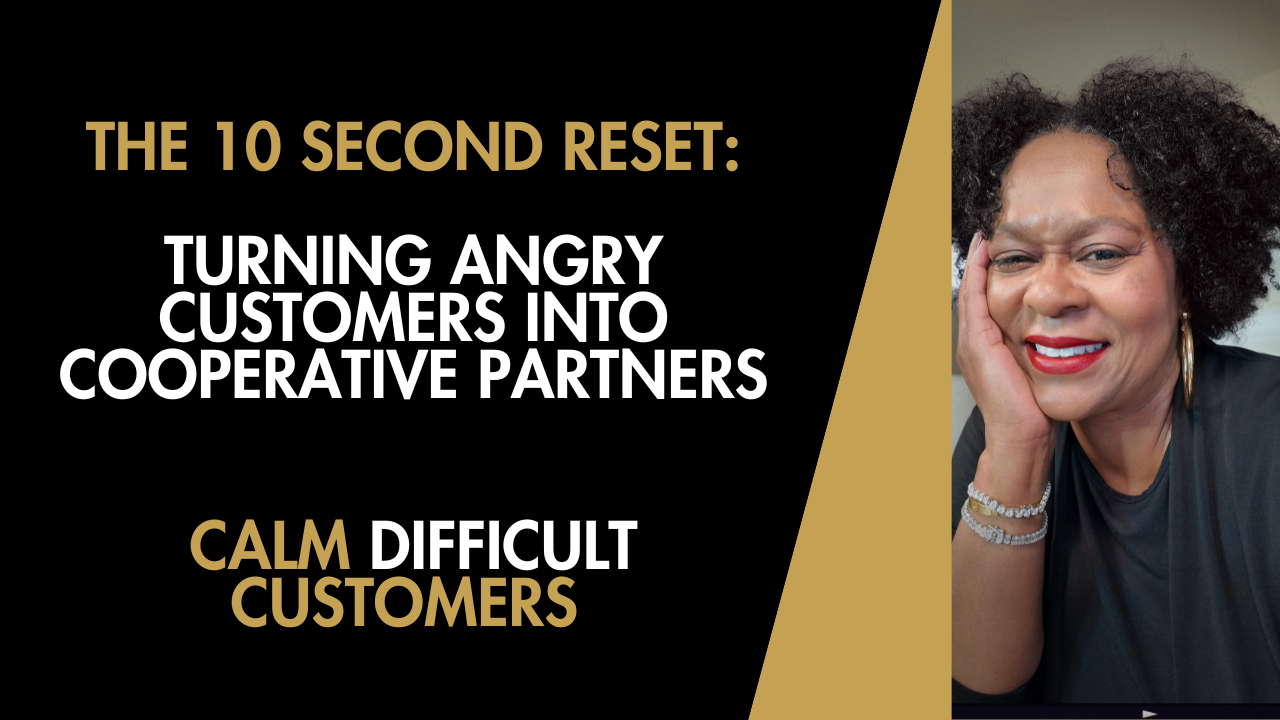The 10 Second Reset: Turning Angry Customers into Cooperative Partners

Picture this: an angry customer is on your phone, voice raised, cutting you off. Your heart starts racing, your shoulders tense up, and before you know it, you're matching their energy. Sound familiar? We've all been there, and it's not fun for anyone involved.
But what if I told you there's a simple technique that can completely change the trajectory of these heated interactions? It's called the 10 Second Rule, and it's based on solid neuroscience that can help you turn angry customers into cooperative ones.
Here's the thing: when customers are upset, their brains aren't processing logic. They're scanning for safety. In those crucial first 10 seconds of your response, their nervous system is asking one question: "Are you with me or against me?" Your answer to that silent question determines whether the conversation spirals out of control or settles into something manageable.
Let me share four powerful techniques that will help you make those 10 seconds work in your favor.
1. The 10 Second Breath Reset

Your calm becomes their calm. It's that simple. When customers are in what we call "limbic hijack" - that state where emotions have taken over - they can't process information. They can only pick up on your tone, pace, and presence.
That's why your first 10 seconds matter more than your first words.
Before you respond to an angry customer, try this: take a deep, intentional breath. Inhale for four counts, exhale for six. This isn't just about centering yourself (though it does that too). Through something called mirror neurons, your calm actually helps regulate their nervous system.
Then begin with a grounding acknowledgment like: "I can hear how much this has impacted you."
Notice what happens here. You haven't solved anything yet, but you've already started shifting their emotional state. Your breath regulates their breath. Their nervous system begins to soften before you've even addressed the actual issue.
2. The 10 Second Validation Window

Here's where most of us get it wrong. When a customer is upset, our instinct is to jump straight into problem-solving mode. "Let me look into that," or "Here's what happened," or even worse, "That's not how it works."
But solutions delivered too early feel like resistance to an angry customer. Validation delivered early feels like safety.
Spend your first 10 seconds doing nothing but acknowledging the emotional impact. Try phrases like:
- You've been dealing with this way too long
- I understand why you're upset
- Let's take this one step at a time
This validation interrupts their threat response and shifts their brain toward cooperation. Only after you've created this safety window do you move to next steps. It's a small shift that makes a huge difference.
3. The 10 Second Redirect
A customer stuck in an anger loop isn't ready for policy explanations or boundaries. But after 10 seconds of calm presence and validation, their brain becomes receptive to redirection.
Here's your magic phrase: "And here's what we can do next."
This simple sentence, delivered after a calm pause, acts like a psychological escort. It acknowledges what happened, moves the customer toward the future, breaks the emotional loop, and gets them following your lead.
The key is timing. The redirect only works because you didn't rush it. You gave their nervous system time to shift gears.
Learn more and take the first module free!
4. The 10 Second Closure

Sometimes the answer is no, and that's okay. But when you have to deliver unwelcome news, the next 10 seconds are absolutely crucial.
If you rush, over-explain, or soften excessively, the customer senses uncertainty and pushes harder. But when you hold a calm, measured rhythm, their nervous system hears the message before their mind does: "This is final. This is safe."
Try this structure:
- Pause
- State the boundary with a steady tone
- Immediately offer the next step that is available
- Pause
It might sound like: "Here's what I can do for you today." (Pause) "And that will complete what I'm able to do on this."
That rhythm signals certainty, and certainty diffuses resistance.
The Science Behind the Magic

What makes the 10 Second Rule so effective isn't magic - it's neuroscience. When someone is angry, their brain is in survival mode. Logic takes a backseat to emotional processing. By giving yourself and them those crucial 10 seconds, you're allowing their nervous system to shift from threat detection to trust building.
Remember, you're not just managing a conversation - you're managing nervous systems. Yours and theirs. When you approach angry customers with this understanding, everything changes.
Practice Makes Perfect
Like any skill, the 10 Second Rule takes practice. Start by becoming aware of your own reactions. Notice when you feel that urge to respond immediately. That's your cue to pause, breathe, and reset.
The beautiful thing about this technique is that it works even when you're having a tough day. Even when you're feeling stressed or overwhelmed, those 10 seconds give you the space to respond rather than react.
Your customers will notice the difference immediately. Instead of escalating conflicts, you'll find yourself naturally de-escalating them. Instead of dreading difficult interactions, you'll feel more confident and in control.
The 10 Second Rule isn't just about better customer service - it's about creating better experiences for everyone involved, including you. So the next time you're faced with an angry customer, remember: pause, breathe, and let those 10 seconds work their magic.
De-escalation Academy
The step-by-step, psychology-backed system that helps your team handle any tough customer interaction with calm, control, and confidence—on the phone, in person, or in chat.
Join Myra’s Inner Circle: Insights, Strategies, and Resources for Leaders Who Demand the Best.
Be the first to receive exclusive strategies, curated resources, and behind-the-scenes insights from Myra Golden—crafted for leaders who value excellence.
Your information will remain private and protected—always.

